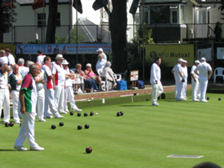Article 3 - Bias
ARTICLE 3 - Bias
(Originally published in 1997 and
revised in 2009 & 2019)
Bias The Oxford English Dictionary considers the first use of
the word, as follows "Originally an adjective, as in PR. "Via
Biayssa" - cross or oblique road". The seamstresses amongst you
will also recognise the use "on the bias" -being "diagonally,
across the textures". The dictionary does say that the word became
the technical term at the game of bowls, whence comes all the
latter uses of the word.
So we can see that 'bias' comes from the bowl running obliquely
to the line on which it was delivered. Again, referring to the
Oxford English Dictionary, there are two very good paragraphs which
are worth bringing to this article. They are as follows "a term of
bowls applied a like to : the construction or form of the bowl in
parting an oblique motion..... thus a bowl is said to have a wide
or narrow bias. The second makes mention as follows "formally bias
was given by loading the bowls on one side with lead and this was
itself sometimes called the bias..... ..... they are now made of
very heavy wood and the bias given entirely by the shape, which is
that of a sphere slightly flattened on one side and protuberant on
the other, as if composed of the halves of an oblate and prolate
spheroid".
Well that has helped my education !!! but I wonder about the
artificial weighting - certainly the story about the Duke of
Suffolk's experience in 1522, may support it. Although, I always
understood the significance of the story of when he discovered that
his hastily cut bowl from the bannister post, having bias was thus
able to "go round" the blocking bowls and giving him an advantage.
I feel indicating that the other opponents bowls actually ran
straight, not having bias introduced by another means..
Just a note, all artificial weighting is illegal - despite this
when bowls come in for service, there are still some bowls that
people have tried to 'adjust' the bias with loading.
The simplest way to show the bias effect and produce same is to
take a snooker ball and produce a flat on one face and then run
that ball on the table. Such a ball rolled along the table will
turn away from the ''flatten" side, (just as for the Duke of
Suffolk) and you have thus produced a biassed ball. Basically the
side which has been ''flatten" is now lighter than the other side
so the ball falls to the heavier side - the centre of gravity of
the ball has been shifted from the centre of the ball.
This the simplest method of producing bias as described,
obviously has to be modified for the production of a bowl so that
the bowl can be comfortably handled.
Originally, with Lignum Vitae, (wooden) bowls the shift in the
centre of gravity, used to produce the bias was more easily seen by
the bowler. The reason being that as the timber is has a specific
gravity of about 1.32 it needs a larger percentage of its mass to
be 'off centre' to produce the bias. The more modern phenolic bowls
using higher specific gravity material than Lignum Vitae means that
that shift in the centre of gravity is visually less obvious, but
is still there nevertheless.
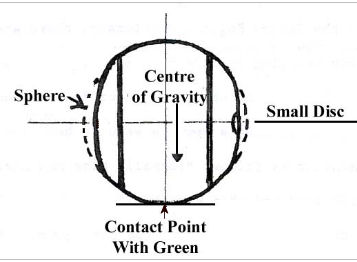
However, the bias can also be produced
by adjusting the running sole, and any of you that have had your
bowls adjusted will know that this in the method used to produce a
change in a bowl to a required bias. At the Drake Pride factory,
because we renovate large numbers of Lignum Vitae bowls (for the
Crown Green players) where basically every set has to be re-biassed
during renovation procedures, we therefore, have great experience
and skill in the intricacies of hand biasing. However, as we now
are producing the modern phenolic bowls on computer controlled
lathes, it means that another set of skills is required to ensure
that the bowls run as the manufacturer requires.
In 2019 Jean and Maurice Roger of
Pershore Bowls Centre donated several items to the Bowls Heritage
Collection. Amongst the items Was a booklet published by
Taylor-Rolph in 1938. In the booklet was an interesting article -
titled "What is Bias"
It is worth reading so a copy is below:-
WHAT IS BIAS ?
A rather technical article, but
worth reading because it shows you why bowls behave as they do on
the green, and how the draw of any given bowl is
determined.
"Bias: a technical term of the game of bowls, whence came all
the later uses of the word. Origin unknown."
So says the dictionary, but here it is
necessary to amplify this terse definition. Bias is given to a
bowl, not by any form of loading but entirely by its shape, which
is that of a sphere having one side slightly flattened and the
other protruding. This peculiar shape displaces the centre of
gravity from the centre line, causing the bowl, when rolled upon a
flat surface, to take a curved path during its progress.
The degree of bias is determined by the
extent of the displacement of the centre of gravity, or the
inclination of the axis (from plate to plate of the bowl) caused by
the displacement. The gyroscopic action of the moving bowl bowl
resists this inclination, which imparts a turing movement to the
bowl. It is this that causes the bowl to move in a curved path. The
curvature of the path increases as the bowl loses speed and come to
rest.
Reference to the diagram will explain the
behaviour of a bowl in play. A is the point of delivery and B the
point at which the bowl comes to rest. The area bounded by the
straight and curved lines is known as the amount of 'land' taken by
a given bowl, in a given length, on a given surface.
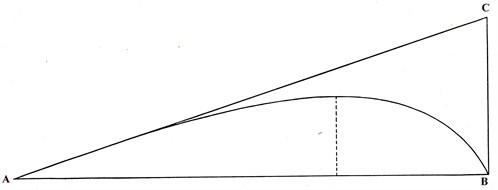 A
light weight bowl requires more initial velocity and takes more
'land' to reach its destination than a heavy bowl. Apart from any
unevenness or downward slope, the heavier and slower the green, the
less 'land' will be taken by any particular bowl. The reason is
that on a keen or fast green the contact between bowl and surface
is very small. Friction is therefore less and the bowl will travel
faster in its natural course than on a heavy green. The curve will
be wider and consequently more 'land' will be taken.
A
light weight bowl requires more initial velocity and takes more
'land' to reach its destination than a heavy bowl. Apart from any
unevenness or downward slope, the heavier and slower the green, the
less 'land' will be taken by any particular bowl. The reason is
that on a keen or fast green the contact between bowl and surface
is very small. Friction is therefore less and the bowl will travel
faster in its natural course than on a heavy green. The curve will
be wider and consequently more 'land' will be taken.
The draw of any given bowl in play is
determined by the length B - C
over a given length A-B. A-C is the direction in which the
bowl is delivered to reach the position of rest B.
The draw of any given bowl in play is
therefore governed by the nature of the surface upon which it is
delivered. Provided the surface is the same, A-C will remain in
ratio to A-B irrespective of its initial velocity.
The behaviour of a bowl in play is
determined by the weight, velocity of delivery, its bias (or
displacement of the centre of gravity from the bowl's centre) and
finally, by the nature of the surface upon which it is
delivered.
The article "What is Bias?"was
published by Taylor-Rolph in 1938
All manufacturers now use computer controlled. lathes (Drake
Pride being the first company to install such equipment) and
therefore the modern bowls no longer require hand biassing as the
programmes that are used produce the 'total' geometric shape of the
bowl. This may incorporate some shaping of the running sole, but
all the shape is produced on the lathe, combining with the gravity
shift and the mix of how these two basic methods are used is how
the different manufacturers produce the different handling
characteristics of their models.
From an interesting old book 'The Physics of Ball Games" there
is a section on "the path of a a wood" across a bowling green, and
this is worth producing as in relatively simple terms it does
explain how the curved path of the bowl is produced.
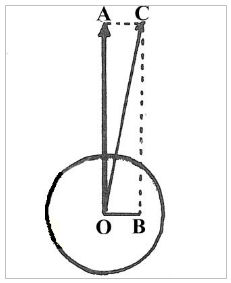
THE PATH OF A 'WOOD' ACROSS A
BOWLING GREEN:
Fig B.
The fact that a bowls 'wood' which has
bias pursues a curved path across the green is a result of the
principle of conservation of angular momentum, and its motion is
best explained on that basis.
However, it is fairly easy to accept, at least in general terms,
why it behaves as it does.
Fig. B is meant to represent such a wood, seen from above,
rolling across a green in the direction of the arrow OA.
Since it is rolling, the top of the wood will be moving with a
velocity in this same direction. Suppose the bias is on the right;
that is to say, the centre of gravity of the wood Is to the right
of its centre. Then this bias will tend to rotate the wood over
from left to right, and so give the top of the wood a small
velocity in the direction OB This, combined with the very much
greater velocity along OA will give a combined velocity somewhat to
the right of OA-along OC. It is therefore in this direction that
the wood will tend to roll. In this way it will always tend to roll
slightly to the right of the path on which it finds itself. In the
early stages, when it is rolling rapidly forwards, the velocity
along OA is very much greater than that along OB, and so the
curvature of the path will be slight. Later on, as it slows down,
the transverse velocity becomes relatively more important, and the
curvature in the path gets greater and greater, until the bowl
eventually stops rolling and comes to a halt.
In 2019 Jean & Maurice Rogers, the owners of Pershore Bowls
Centre kindly donated to the Collection bowls items. One of which
was a booklet title BOWLS published by The Taylor -Rolph Company
Ltd. in 1938. In it was an article titkes 'What is Bias' and so we
thought it worth adding to our 2017 article and is shown below
:-
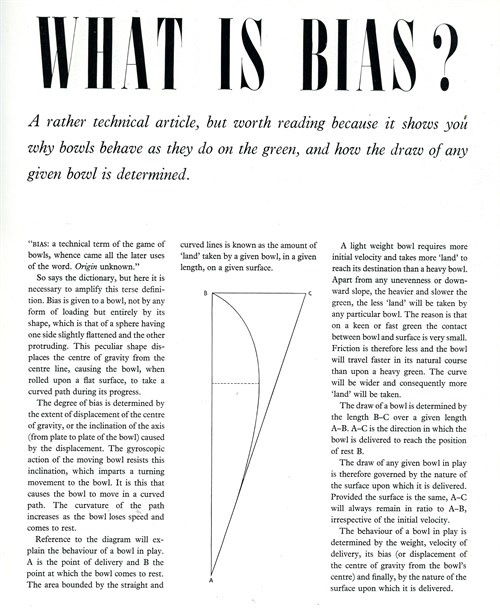
© Peter Clare 2019 - © E.A. Clare
& Son Ltd. 2019 - reproduction of article allowed only with
permission from E.A. Clare & Son Ltd.
I
